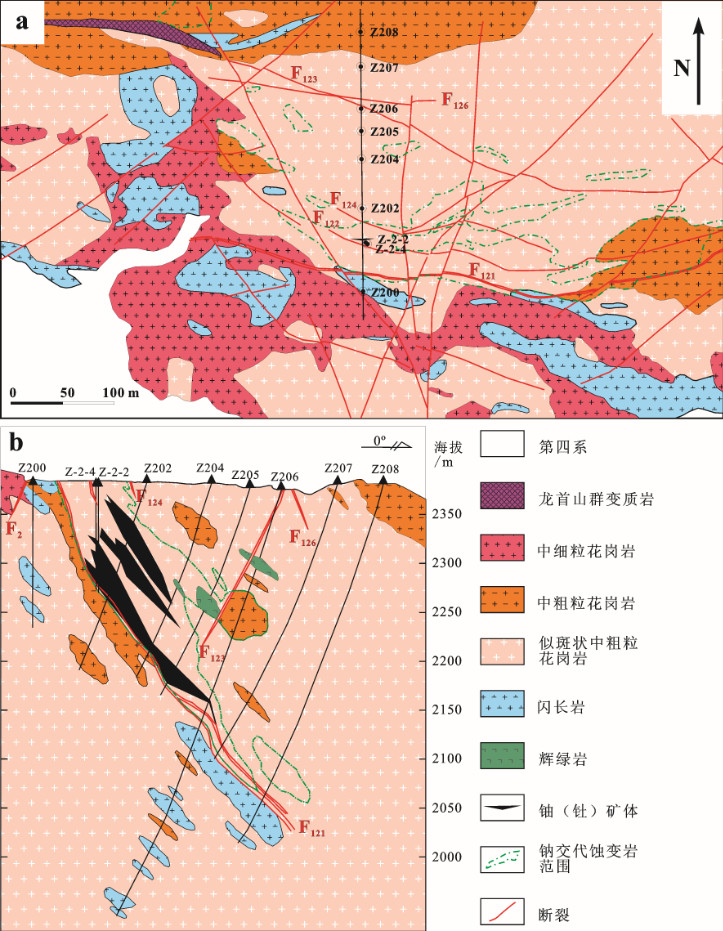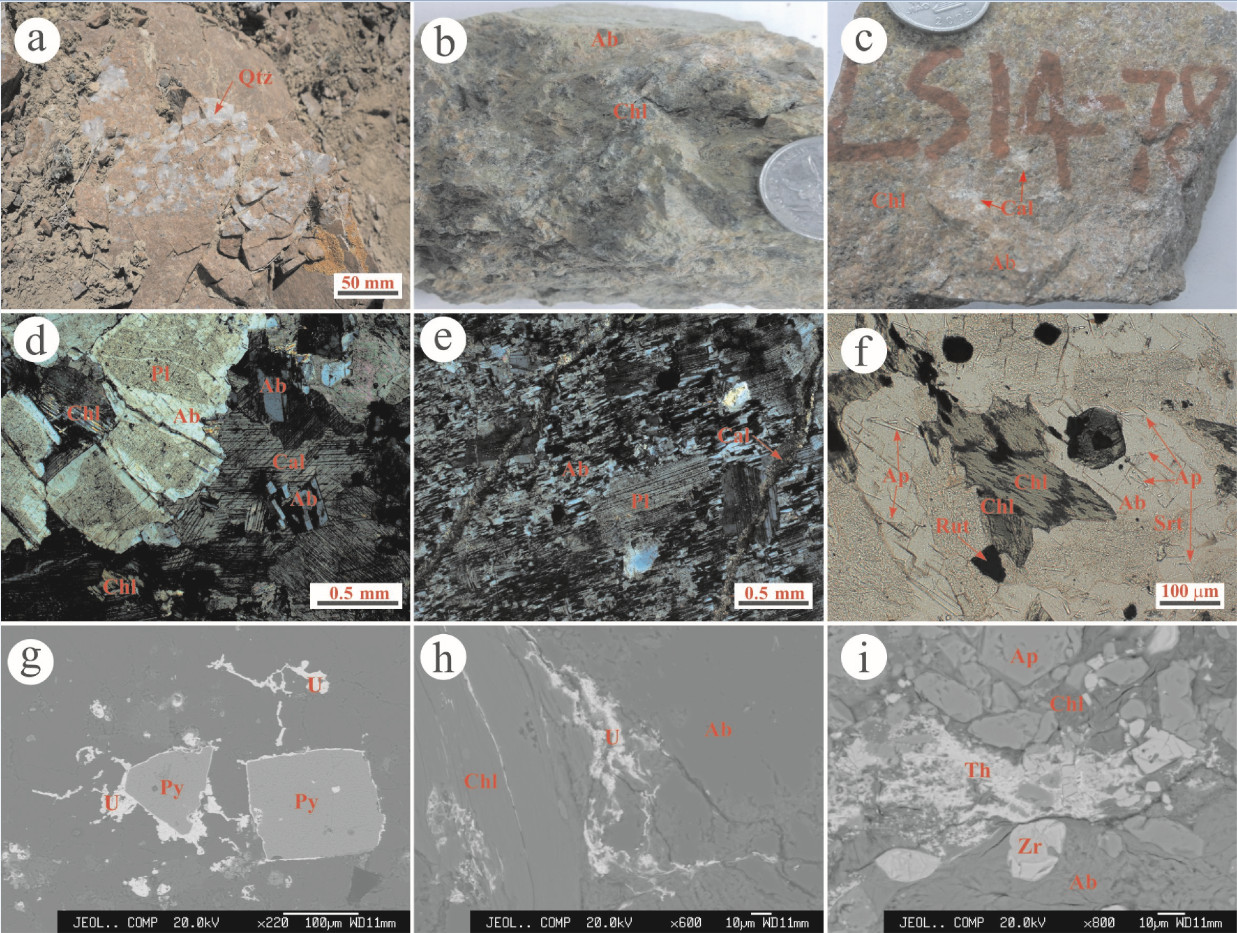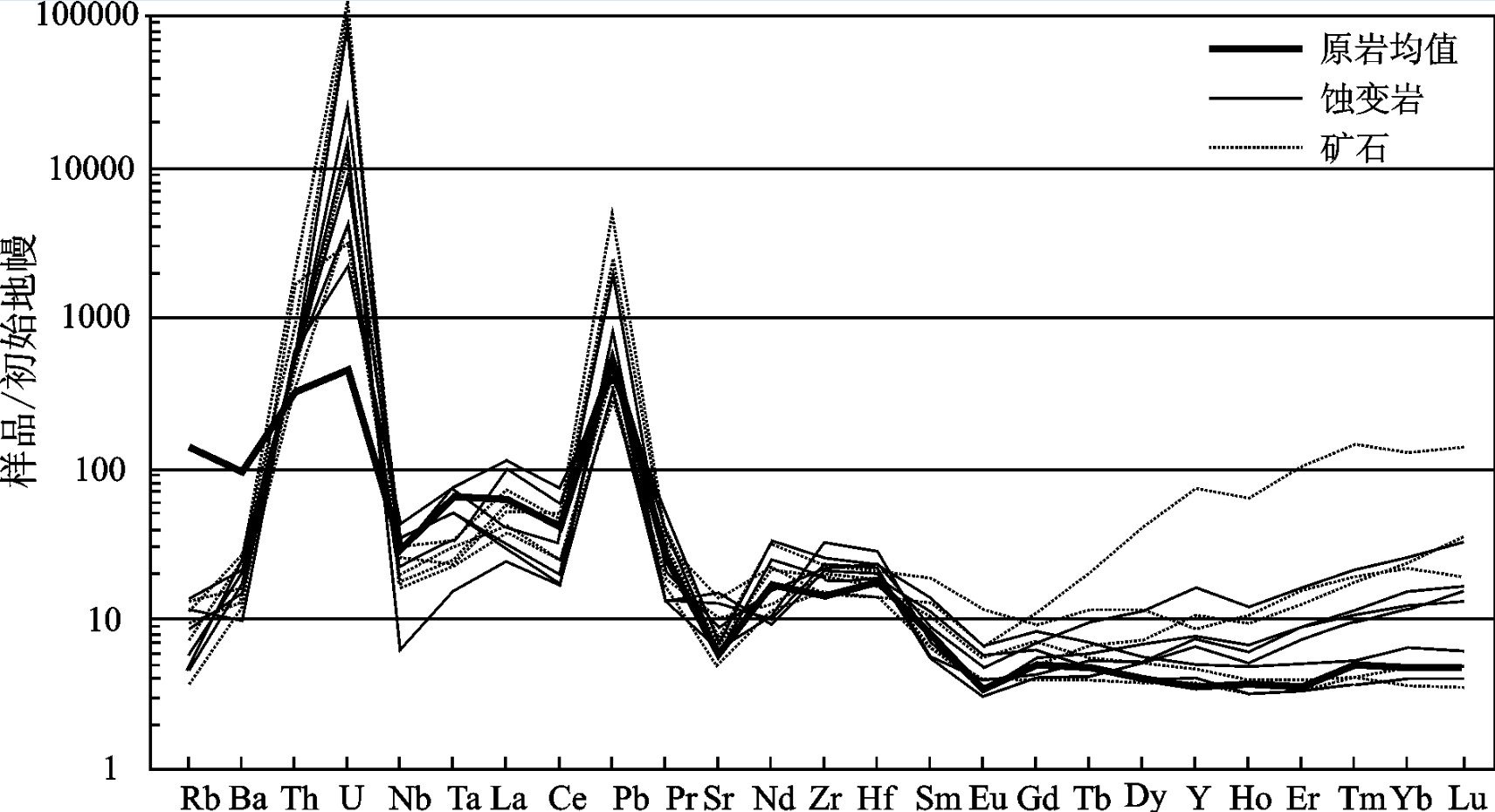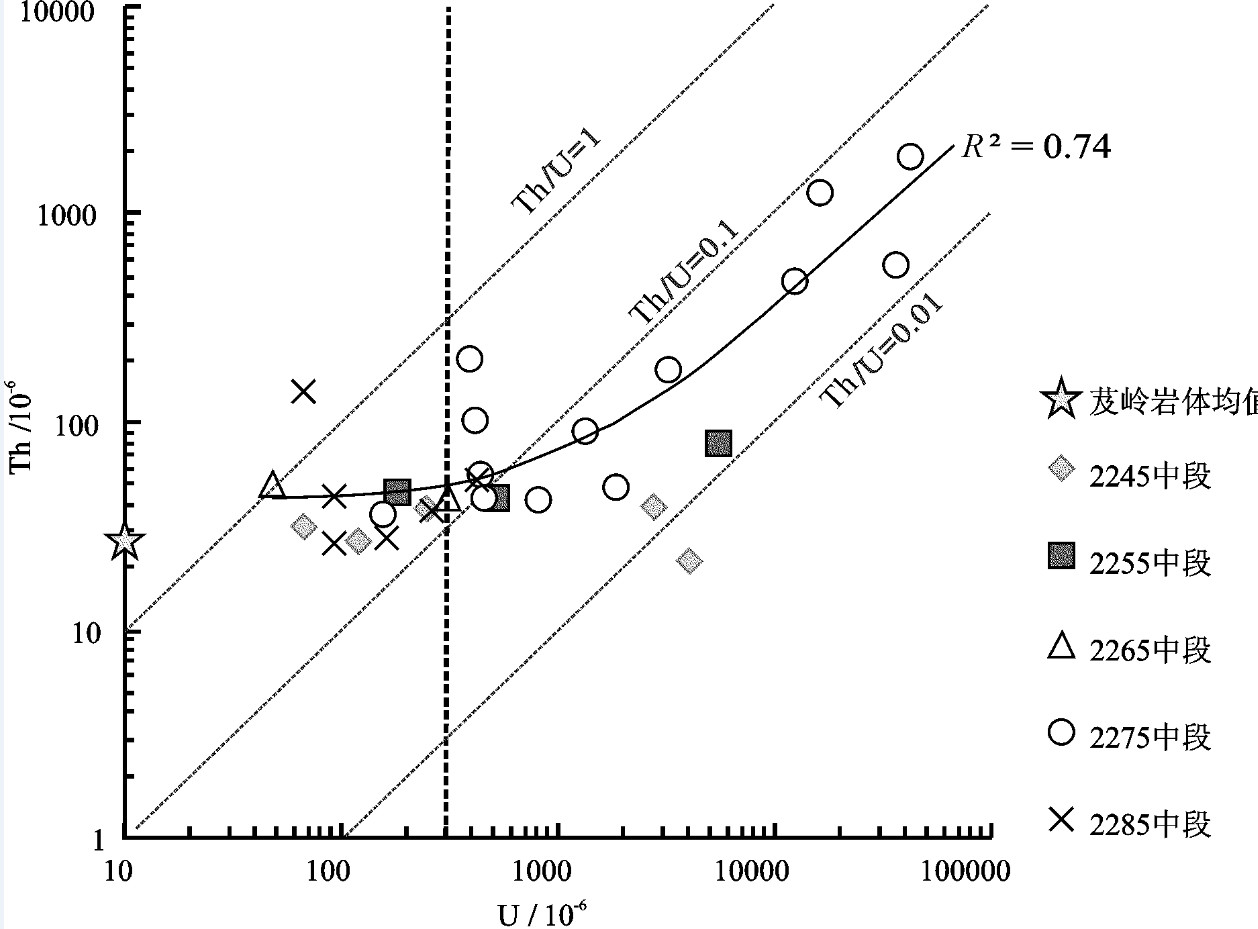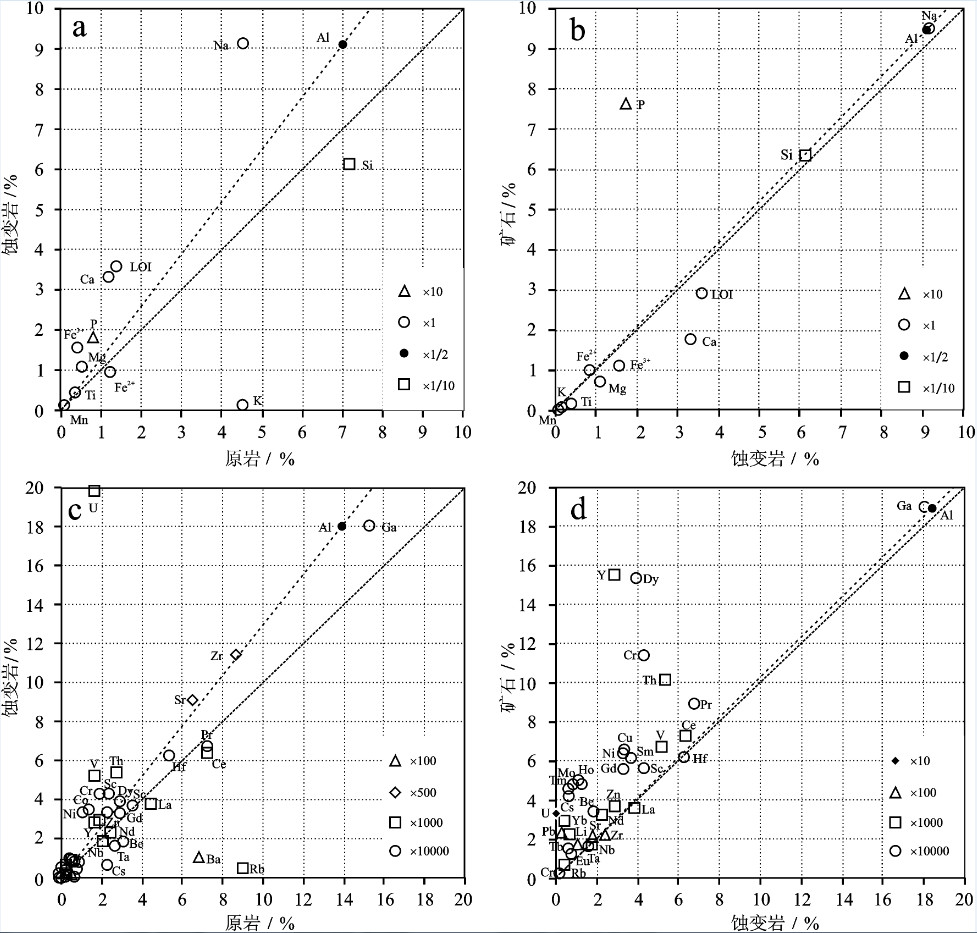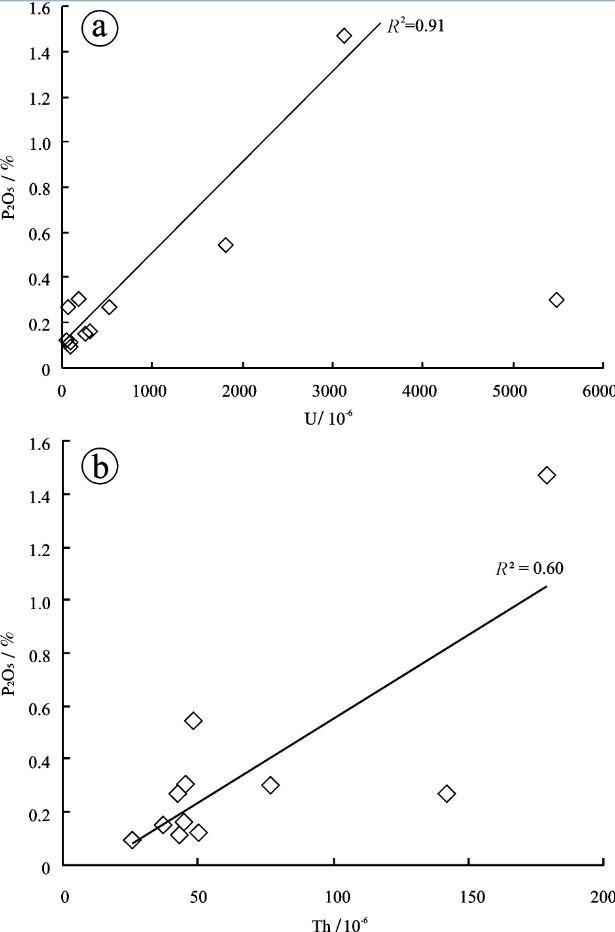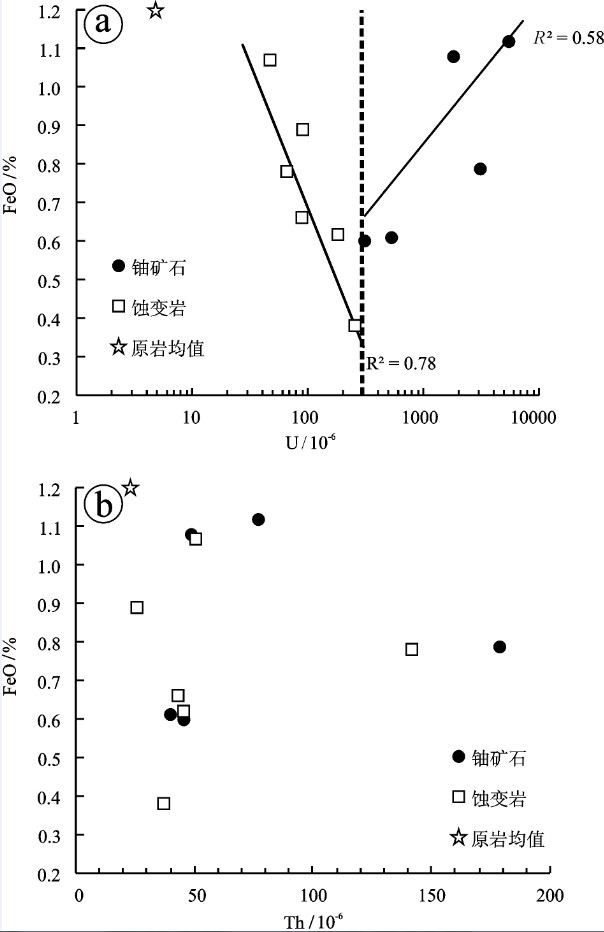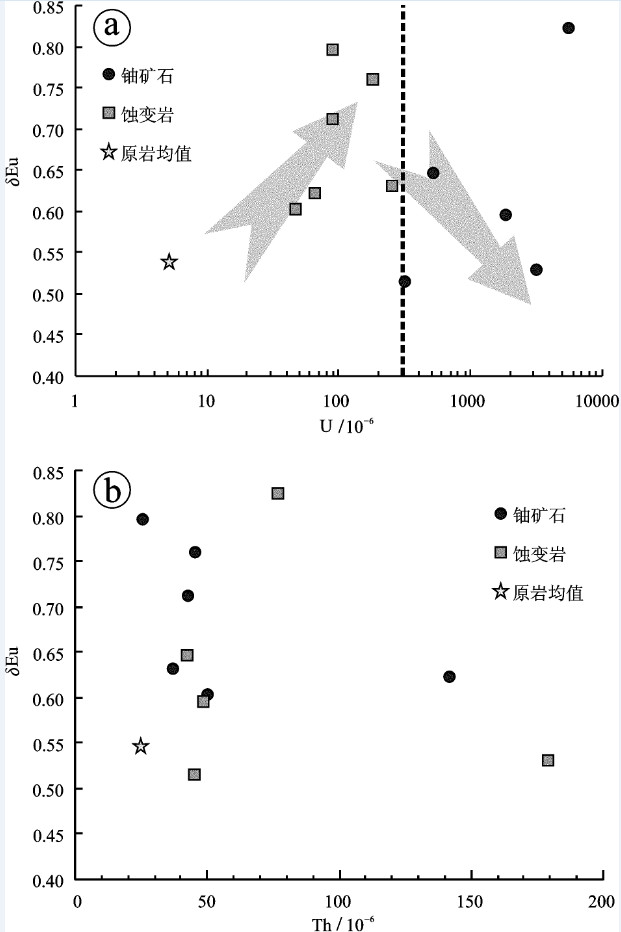Major and trace element migration and metallogenic processes of the Xinshuijing U-Th deposit in the Longshoushan metallogenic belt, Gansu Province
-
摘要:
新水井铀(钍)矿床位于甘肃省龙首山成矿带,是碱交代型铀矿床的典型代表,其矿体完全产于钠交代蚀变花岗岩中,成矿过程可划分为钠交代蚀变、铀钍矿化和成矿后3个主要阶段。文章对该矿床花岗岩原岩、蚀变岩及矿石开展了系统主微量元素分析,采用Grant等浓度线法探讨了钠交代蚀变和铀钍矿化阶段的元素迁移规律,结果表明:钠交代蚀变阶段为富含Na、Ca、过渡族元素(Sc、V、Cr、Co、Ni)、U、Th及CO2、H2O等挥发分的复杂流体,钠交代过程中原岩中的大离子亲石元素(Rb、Ba)和部分轻稀土元素(LREE)不同程度带出;而铀钍成矿阶段成矿流体则富集重稀土元素(HREE)、U、Th、PO43-等成分,CO2等挥发分大量逸出。结合前人研究,认为新水井矿床成矿流体可能来自地幔流体和大气降水热液的混合;等挥发分CO2的逸出是新水井矿床最重要的矿质沉淀机制,导致了铀钍矿物和磷酸盐矿物(磷灰石)的共沉淀,而磷灰石的沉淀又促进了以磷酸盐形式搬运的Th元素的沉淀。
Abstract:The Xinshuijing U-Th deposit in the Longshoushan metallogenic belt of Gansu Province is a typical alkali metasomatic U-Th deposit hosted in albitite. The ore-forming processes can be divided into three major mineralization stages, i.e., Nametasomatism, U-Th mineralization and post-ore stage. In this paper, the authors systematically analyzed major and trace elements in less-altered granite, albitite and ore of the Xinshuijing deposit, and discussed the element transportation using the isocon diagram proposed by Grant. During the Na-metasomatism stage, Na, Ca, Sc, V, Cr, Co, Ni, U, Th and CO2, H2O were enriched, while large ion lithophile elements and some of the light rare earth elements were depleted. The ore-forming fluids of the U-Th mineralization stage were rich in heavy rare earth elements, U, Th, PO43-, with volatile components (CO2, H2O, F, etc) abundantly escaped. Combined with former studies, the authors hold that the ore-forming fluid was the mixture between the mantle fluid and meteoric water. Vapor escape and the oxygen fugacity decrease seem to have been the major mineralization mechanism, which induced coprecipitation of U-Th minerals and apatite. Th transported in the form of compound phosphate was further precipitated after apatite formation.
-
1. 前 言
碱交代型铀(钍)矿床是一种非常重要的热液铀(钍)矿床类型。这类铀(钍)矿床在乌克兰、澳大利亚、巴西、捷克、圭亚那、美国、加拿大等地皆有产出[1], 尽管该类矿床的铀平均品位大都低于其他类型铀矿床(尤其是砂岩型铀矿), 但其往往具有可观的资源量, 且构成大规模铀成矿区带, 如乌克兰地盾的中部铀矿省[2]、捷克OkrouhláRadouň铀矿床[3]、澳大利亚Valhalla铀矿床[4]、中国辽东连山关铀矿[5]、赣南河草坑铀矿[6]、粤北诸广和贵东铀矿集区[7-8]、以及本文研究对象龙首山铀(钍)成矿带[9-13]。此类矿床铀(钍)矿体皆赋存于碱交代蚀变岩中, 与碱交代热液活动有密切的成因关系[1, 14-15], 其成矿热液可能为岩浆热液[14-17, 10]、盆地卤水或循环大气降水[2, 18-19]、以及多种来源的混合流体[3-4], 成矿流体作用过程极为复杂[2]。
自20世纪60年代, 程学友先生在龙首山地区发现中国首例碱交代型铀矿床——芨岭矿床之后, 在其周边相继发现了一系列碱交代型等铀(钍)矿床和矿点[9-10, 20](图 1)。其中, 本文研究对象新水井铀(钍)矿床便是此类矿床的典型代表。前人工作已基本查明新水井矿床地质特征[9, 21], 并重点对碱交代蚀变开展了相关地球化学分析[22, 12-13, 15] ❶ ❷, 为新水井矿床成矿规律总结与成因研究提供了重要约束, 但在碱交代蚀变与成矿关系、铀钍共生机理和成因、以及成矿流体性质、演化及矿质沉淀机制等方面仍较为薄弱, 而上述问题往往是认知成矿作用过程和总结成矿规律的关键, 因此急需加强相关工作。
❶ 李占游.芨岭花岗岩及钠交代热液铀矿化的稳定同位素及稀土元素研究[R].咸阳:二零三研究所, 1987.
❷ 魏观辉, 刘玉和, 王连香.龙首山地区碱交代热液铀矿床形成地球化学机理探讨[R].咸阳:二零三研究所, 1987.
针对上述存在问题, 本文在前人工作的基础上, 结合详细的岩/矿相学观察, 对新水井铀(钍)矿床中的未蚀变新鲜岩石、蚀变岩及矿石开展了主微量元素对比分析, 阐述了新水井矿床成矿过程中的元素迁移规律, 反演了成矿流体性质和来源, 并对铀钍沉淀机制进行了探讨。
2. 区域地质
龙首山铀(钍)成矿带是祁连—秦岭铀成矿省的重要组成部分[21], 构造位置上位于华北板块西南缘的阿拉善地块西南缘(图 1-a), 北接潮水盆地, 南部以龙首山断裂为界与河西走廊盆地相接。
区内出露最老地层为古元古代龙首山群斜长角闪岩、混合岩、大理岩和片岩等, 前人获得混合岩和变辉绿岩全岩Sm-Nd模式年龄介于2721~1508 Ma[23], 3个单颗粒锆石U-Pb年龄分别为(1914±9)Ma[24]、(2015±16)Ma[25]和(2034±16)Ma[26]。中元古代墩子沟群和震旦系韩母山群低级变质岩不整合覆盖于龙首山群之上, 其中, 墩子沟群主要岩性包括千枚岩、板岩、灰岩、变质砂岩、石英岩等[27](图 1-b), 而韩母山群则主要由低级变质板岩、灰岩组成[28], 最新研究认为韩母山群下部烧火筒组为震旦系沉积, 而上部草大坂组灰岩和碎屑岩沉积则被划归为寒武系[29-30]。本区古生代和中生代沉积较少, 仅零星出露于龙首山NW和SE端(图 1-b), 主要包括早石炭世灰岩夹砂岩沉积和早白垩世砂砾岩等。
龙首山地区岩浆作用广泛而强烈, 自超基性到酸性岩浆岩皆有出露。其中, 基性岩浆岩以与超大型金川铜镍硫化物矿床相关的基性杂岩为代表[32, 23], 酸性岩浆岩则以芨岭复式岩体为代表, 芨岭岩体主要位于龙首山中段(图 1-b), 侵位于加里东期, 主要岩性从早至晚包括细粒闪长岩、中粗粒黑云母花岗岩、似斑状中粗粒黑云母花岗岩和中细粒花岗岩等。龙首山铀(钍)矿化皆产于芨岭岩体中, 地球化学研究表明, 芨岭岩体岩浆源区以古元古代龙首山群组成的残留地壳物质为主, 其次为中元古代地层贡献, 另有少量幔源物质的加入[33]。
本区经历了多期构造岩浆事件, 尤以加里东期碰撞造山作用最为强烈, 影响范围最为广泛, 导致区内古生代地层普遍缺失, 前古生代地层整体构成了轴向NW的背斜构造, 并形成了以NW向、近EW向和近S-N向为主的多期多组断裂构造(图 1)。其中, NW和近E-W向断裂系控制了龙首山地区的地层展布、岩体侵位和矿床的形成; 而近S-N向断裂则多为成矿后断裂, 错段早期断裂带和地质体。
截至目前, 龙首山铀(钍)成矿带已发现多种类型铀(钍)矿床/点, 包括伟晶岩型(如红石泉[34, 35])、硅质脉型(革命沟)、淋积型(如金边寺[36])等, 但最为重要的仍是碱交代型, 以芨岭和新水井矿床为典型代表[21, 15, 10]。
3. 矿床地质
新水井铀(钍)矿床位于龙首山成矿带中部, 矿区地层极少, 仅有古元古代龙首山群大理岩和片岩局部出露矿区西北部。整个矿区出露的主要岩石单元为加里东期芨岭复式岩体, 由中细粒闪长岩、中粗粒黑云母花岗岩、似斑状中粗粒黑云母花岗岩和中细粒花岗岩构成。其中, 新水井矿床的主要赋矿围岩为似斑状中粗粒花岗岩, 中粗粒黑云母花岗岩次之(图 2)。钻孔揭露矿区深部出现后期辉绿岩脉(图 2-b), 侵入于芨岭岩体之中。
矿区断裂构造极为发育, 包括NW、NE、近S-N和E-W向4组(图 2-a)。其中, NW向和近E-W向断裂为成矿前或成矿期断裂, 控制了矿体的产出, 其中, 最为主要的控矿断裂为区域马路沟断裂的分支断裂F121和F122, 新水井铀(钍)矿体和相关的碱交代蚀变体便产于该断裂上盘; NE和近S-N向断裂多为成矿后断裂, 错段NW向及近E-W向断裂(图 2-a)。
新水井铀(钍)矿床3个主矿体皆为隐伏矿体, 位于F121断裂上盘, 呈雁列式展布, 矿体形态简单, 呈大脉状、透镜状, 矿体走向为近E-W向, 向北陡倾, 倾角约65°(图 2-b)。新水井矿床铀钍矿化存在分带性, 铀矿化主要赋存标高介于+2035~+2370 m; 而钍矿化多位于地表及地表以下80~100 m范围内(+2285 m中段之上)。新水井矿床最为主要的蚀变类型为钠交代蚀变, 铀(钍)矿化与碱交代蚀变作用具有密切的空间耦合关系, 铀(钍)矿体完全产于破碎的钠交代蚀变岩中(图 2-b)。
根据矿物组合及穿插交代关系, 本文将新水井矿床划分为钠交代蚀变、铀钍矿化及成矿后3个主要成矿阶段。
钠交代蚀变阶段规模较大, 遍及整个矿区, 该阶段钠交代蚀变作用基本保留了花岗质原岩结构构造, 蚀变矿物组成较为简单, 以钠长石为主, 次为赤铁矿、方解石和绿泥石(图 3-a~d), 钠长石广泛交代花岗岩原岩中的钾长石、斜长石(图 3-d, e)等, 伴随的“排硅”作用溶解了原岩中的石英, 并在后期局部聚集再沉淀(图 3-a), 或形成空洞并被后期方解石、绿泥石和少量新生细粒钠长石充填; 绿泥石多呈片状或蠕虫状, 为黑云母交代产物(图 3-f, h), 成分以铁镁绿泥石为主[22]; 方解石多呈雪花状, 白色或淡粉色(图 3-c); 而赤铁矿则多呈絮状附于晶体表面或充填于矿物裂隙(图 3-g), 导致了碱交代蚀变岩特征性的红色宏观特征(图 3-a~c)碱交代蚀变阶段伴随较弱的铀钍矿化,野外能谱测量铀钍值明显高于未蚀变原岩。
![]() 图 3 新水井矿床手标本及镜下显微照片a—钠交代蚀变岩中的“排硅”现象,溶解的石英后期再沉淀于钠交代蚀变岩局部;b—新水井矿石照片(U含量为522×10-6),全岩蚀变,主要矿物包括钠长石(铁染呈红色)、绿泥石;c—新水井矿床碱交代蚀变岩,主要组成矿物包括钠长石、雪花状方解石、绿泥石、赤铁矿等;d—赤铁矿絮状充填的钠长石边部为新生细粒钠长石沿边部交代(左上),方解石、绿泥石和少量细粒新生钠长石充填于溶蚀矿物(可能主要为石英)而形成的空洞之中(右下);e—棋盘格状钠长石交代斜长石,后者呈交代残余孤岛,后期方解石脉穿切钠长石;f—绿泥石交代黑云母,与针柱状磷灰石、金红石共生;g—沥青铀矿包裹黄铁矿颗粒产出;h—沥青铀矿呈细脉状沿绿泥石解理和外侧裂隙产出;i—含钍矿物(化学成分接近水氟碳钙钍矿)与磷灰石、绿泥石、锆石沿裂隙充填Figure 3. Photographs showing ore fabrics and mineral assemblages of the Xinshuijing deposit.a-dequartzification of the albitite; b-ore sample with U content of 522×10-6; c-typical albitite; d-albite replaced and surrounded plagioclase (upper left), and minor fine-grained albite intergrown with calcite and chlorite filled in the void formed by quartz (or other minerals) dissolution; e-chessboard-shaped albite replaced plagioclase and was cut by the late-stage calcite veins; f-biotite was replaced into chlorite, accompanied by rutile formation and abundant occurrence of rod-like apatite; g-pitchblende surrounding pyrite; h-pitchblende filled in the fractures and cleavage of chlorite; i-Pitchblende and pyrite filling the fractures of albite
图 3 新水井矿床手标本及镜下显微照片a—钠交代蚀变岩中的“排硅”现象,溶解的石英后期再沉淀于钠交代蚀变岩局部;b—新水井矿石照片(U含量为522×10-6),全岩蚀变,主要矿物包括钠长石(铁染呈红色)、绿泥石;c—新水井矿床碱交代蚀变岩,主要组成矿物包括钠长石、雪花状方解石、绿泥石、赤铁矿等;d—赤铁矿絮状充填的钠长石边部为新生细粒钠长石沿边部交代(左上),方解石、绿泥石和少量细粒新生钠长石充填于溶蚀矿物(可能主要为石英)而形成的空洞之中(右下);e—棋盘格状钠长石交代斜长石,后者呈交代残余孤岛,后期方解石脉穿切钠长石;f—绿泥石交代黑云母,与针柱状磷灰石、金红石共生;g—沥青铀矿包裹黄铁矿颗粒产出;h—沥青铀矿呈细脉状沿绿泥石解理和外侧裂隙产出;i—含钍矿物(化学成分接近水氟碳钙钍矿)与磷灰石、绿泥石、锆石沿裂隙充填Figure 3. Photographs showing ore fabrics and mineral assemblages of the Xinshuijing deposit.a-dequartzification of the albitite; b-ore sample with U content of 522×10-6; c-typical albitite; d-albite replaced and surrounded plagioclase (upper left), and minor fine-grained albite intergrown with calcite and chlorite filled in the void formed by quartz (or other minerals) dissolution; e-chessboard-shaped albite replaced plagioclase and was cut by the late-stage calcite veins; f-biotite was replaced into chlorite, accompanied by rutile formation and abundant occurrence of rod-like apatite; g-pitchblende surrounding pyrite; h-pitchblende filled in the fractures and cleavage of chlorite; i-Pitchblende and pyrite filling the fractures of albite铀(钍)矿化阶段中矿石矿物主要呈脉状、网脉状或浸染状穿切或散布于早阶段钠交代蚀变岩裂隙中(图 3-g, h), 主要含铀矿物为沥青铀矿、晶质铀矿、铀黑等, 而钍主要以方钍石及含钍的稀土矿物形式(图 3-i,电子探针分析ThO2含量介于19.5%~23.2%,化学成分与水氟碳钙钍矿相近)存在形式存在。铀矿脉中常见的共生矿物包括黄铁矿、方铅矿等硫化物、以及细粒钠长石、方解石、绿泥石(图 3-d, g~i)和细小针柱状磷灰石(图 3-i)等脉石矿物。
成矿后阶段主要为无矿方解石细脉, 穿切钠交代蚀变岩和铀(钍)矿脉。
4. 样品及测试方法
为研究新水井矿床不同阶段元素变化和迁移规律, 系统采集了新水井矿床不同标高(+2245~+2285 m标高中段)的钠交代蚀变岩(U < 300×10-6)、矿石(U < 300×10-6)和未蚀变似斑状中粗粒花岗岩样品共16件(表 1), 并开展了系统的主、微量元素分析。
表 1 新水井矿床主微量元素分析样品Table 1. Sample description for major and trace element analyses in the Xinshuijing deposit
样品的主微量元素分析皆在核工业北京地质研究院分析测试研究中心开展。主量元素分析采用X射线荧光光谱法(XRF), 测试仪器为利浦PW2404 X射线荧光光谱仪, 测试流程详见文献[37]。实验过程中, X射线管电压为50 kV, 电流为50 mA, 元素的测定精度可达0.01%, 分析误差< 5%。此外, 用化学分析法(CA)测定样片中氧化亚铁的含量(测定范围: >0.5%), 详细的分析流程见中华人民共和国国家标准GB/T 14506.14-2010。
微量元素采用电感耦合等离子质谱法(ICPMS)分析, 样品经溶样定容后, 在德国FinniganMAT公司制造的HR-ICP-MS(ElementⅠ)仪器上进行测定。测试方法依据DZ/T0223-2001方法通则, 工作温度、相对湿度分别为20℃和30%。微量元素含量大于10μg/g时相对误差小于5%, 小于10μg/g时的相对误差小于10%, 分析流程详见文献[38]。
5. 测试结果
新水井矿床花岗岩原岩、钠交代蚀变岩及矿石的主、微量元素分析结果如表 2和表 3所示。
表 2 新水井矿床蚀变岩、矿石及花岗岩原岩主量元素含量(%)Table 2. Major element content (%) of the albitite, ore and less-altered granite samples in the Xinshuijing deposit 表 3 新水井矿床蚀变岩、矿石及花岗岩原岩稀土及微量元素含量(10-6)Table 3. Rare earth and trace element content (10-6) of albitite, ore and less-altered granite in the Xinshuijing deposit
表 3 新水井矿床蚀变岩、矿石及花岗岩原岩稀土及微量元素含量(10-6)Table 3. Rare earth and trace element content (10-6) of albitite, ore and less-altered granite in the Xinshuijing deposit
5.1 主量元素特征
由表 2可知, 蚀变岩和矿石SiO2含量相当, 分别介于57.06%~65.46%(均值61.29%)和57.43%~63.96%(平均63.02%), 皆明显低于花岗岩原岩72.60%的平均含量; 与原岩相比, 蚀变岩和矿石的Al2O3含量皆有所升高, 含量分别为17.01%~19.42%(均值18.20%)和17.15%~19.08%(均值18.74%);Na2O含量明显增高, 分别介于8.19%~10.19%(均值9.16%)和8.45%~10.05%(均值9.44%), 而K2O含量则显著降低, 分别为0.08%~0.21%(均值0.13%)和0.07%~0.15%(均值0.10%); CaO含量变化较大, 蚀变岩和矿石CaO含量分别为0.55%~7.77%和0.97%~7.57%;蚀变岩和矿石中P2O5和MgO都有不同程度增加, 分别为0.09%~0.31%、0.50%~2.24%和0.27%~1.47%、0.36%~1.22%;蚀变岩和矿石中的FeO和Fe2O3呈现相反的增减趋势, 从原岩→蚀变岩→矿石, FeO含量先降低(均值由1.22%→0.70%)再升高(0.70%→1.00%), 而Fe2O3则先增加再降低(0.37%→1.00%→0.02%)。MnO、TiO2含量未发生明显变化。
不同标高(采样中段)样品主量元素含量无显著差异。
5.2 稀土和微量元素特征
新水井矿床原岩、钠交代蚀变岩和矿石的稀土和微量元素含量如表 3, 稀土元素配分曲线和微量元素蛛网图如图 4所示。从原岩→蚀变岩→矿石, ∑REE有所增加(均值自150.82×10-6→154.83×10-6→245.14×10-6), 轻稀土元素变化较小(140.85×10-6→136.50×10-6→156.86×10-6), 但重稀土元素含量呈逐渐增加趋势(9.97×10-6→18.33×10-6→88.27×10-6, 图 4), 导致轻重稀土元素分异程度不断降低, (La/Yb)N自13.54→6.95→1.05变化; δCe无变化, 均值分别为1.00、0.97和0.98;蚀变岩和矿石中δEu较为接近(均值分别为0.67和0.64), 均高于原岩(均值0.54)。微量元素中, 蚀变岩和矿石中的大离子亲石元素(LILE), 如Rb、Ba含量(10-6)皆显著降低(分别为76.59→4.84→6.88和523.17→110.33→169.3), 而高场强元素(如Nb、Ta、Zr、Hf)则相对较为稳定(表 3; 图 4)。此外, 蚀变岩和矿石中U、Th含量(10-6)较原岩皆有显著增加(均值变化分别为4.98→194.9→3437和22.50→3.85→101.3;图 4)。
不同标高稀土和微量元素含量没有明显变化, 整体而言, U、Th具有较好的相关性, 但本次分析的样品中, Th高值基本皆位于+2275 m标高之上(图 5)。
6. 讨论
6.1 流体作用过程中元素迁移规律
热液蚀变作用过程中元素的活化迁移可通过热液作用不同阶段样品的元素含量对比予以反映, 但热液蚀变过程中成矿流体中元素的带入带出必然导致蚀变岩总质量的改变, 这使得原岩和蚀变岩中某种元素含量(%或10-6)的直接对比无法准确反映元素带入带出的相对程度。Grant [40]提出的元素等浓度线法较好地规避了这一问题, 其核心思想是通过确定热液蚀变过程中最为惰性的元素, 并以其为参照(least-altered equivalent)来探讨其他元素的迁入迁出, 该方法应用较多, 取得了较好的实际效果[2, 41, 42]。
本文采用等浓度线法(图 6), 并以Al作为参照元素, 来探讨钠交代蚀变和铀钍矿化2个最为重要的成矿阶段中元素的带入迁出规律。选择Al为参照元素主要基于以下几点:①手标本与镜下岩/矿相观察皆表明热液活动基本保留了原岩结构, 即多为原位蚀变; ②热液蚀变过程中涉及的几个主要化学反应(反应式(1)~(3))中, Al元素皆稳定存在于新生热液蚀变矿物晶格中, 未发生迁移; ③石英溶蚀形成的空洞中充填的新生矿物以方解石、绿泥石为主, 钠长石只是少量存在, 因此石英原位反应形成钠长石过程中(反应(4))的Al元素带入相对有限。

![]() 图 6 钠交代蚀变和铀钍成矿作用过程中元素变异图解a—钠交代蚀变岩相对原岩的主量元素变异图(原点与Al元素间虚线为无元素带入带出的等质量线, 位于此线上部元素在蚀变过程中得到富集, 下部则被贫化。图中斜率为1虚线为蚀变后总质量不变条件下的等质量线, 后图同); b—铀矿石相对蚀变岩的主量元素变异图; c—钠交代蚀变岩相对原岩的稀土和微量元素变异图; d—铀矿石相对蚀变岩的稀土和微量元素变异图Figure 6. Isocon diagram showing element enrichment and depletion during Na-metasomatism and U (Th) mineralizationa-Major element variation diagram during Na-metasomatism stage; b-Major element variation diagram in the U (Th) mineralization stage; c-Trace element variation diagram in Na-metasomatism stage; d-Trace element variation diagram in the U (Th) mineralization stage. Note that the line between the original point and Al point marks the isocon with no element enrichment or depletion. Those plotted above the line were enriched, while below depleted
图 6 钠交代蚀变和铀钍成矿作用过程中元素变异图解a—钠交代蚀变岩相对原岩的主量元素变异图(原点与Al元素间虚线为无元素带入带出的等质量线, 位于此线上部元素在蚀变过程中得到富集, 下部则被贫化。图中斜率为1虚线为蚀变后总质量不变条件下的等质量线, 后图同); b—铀矿石相对蚀变岩的主量元素变异图; c—钠交代蚀变岩相对原岩的稀土和微量元素变异图; d—铀矿石相对蚀变岩的稀土和微量元素变异图Figure 6. Isocon diagram showing element enrichment and depletion during Na-metasomatism and U (Th) mineralizationa-Major element variation diagram during Na-metasomatism stage; b-Major element variation diagram in the U (Th) mineralization stage; c-Trace element variation diagram in Na-metasomatism stage; d-Trace element variation diagram in the U (Th) mineralization stage. Note that the line between the original point and Al point marks the isocon with no element enrichment or depletion. Those plotted above the line were enriched, while below depleted需要说明的是, 石英在碱性溶液中的溶解度将会显著增加[43], 表现为碱交代过程中石英的溶解(所谓“排硅”作用), 载硅溶液沿岩石空洞或裂隙迁移, 并随温度降低溶解度降低而再次沉淀形成团块状石英(图 3-a)。
由图 6-a, c可知, 钠交代蚀变作用过程中, Mg、P带入程度有限, Mn、Ti则保持相对稳定; Si和K大量迁出, 而Na、Ca和挥发分(H2O、CO2等)则大量带入, 这与钠交代蚀变作用过程中钠长石对钾长石和斜长石的大规模交代和“排硅”作用、以及镜下初步观察在“雪花状”方解石中发现的大量CO2-H2O溶液包裹体的地质事实是吻合的; 此外, Fe3+得到了富集, 而Fe2+则相对亏损, 表现为大量“絮状”赤铁矿的产出, 表明钠交代作用流体氧逸度较高(高于赤铁矿-磁铁矿(MH)缓冲对[44])。稀土和微量元素中, Ga、Zr、Hf和Sr元素基本未发生迁移, 落在Al等质量线上(图 6-c); 大离子亲石元素(LILE, 如Rb、Ba等类质同象存在长石等矿物晶格中)大量迁出; 轻稀土元素(LREE, 包括La、Ce、Pr、Nd等)亦不同程度被带出; 而重稀土元素(HREE, 如Dy、Y等)则轻度富集或保持不变; 过渡族元素Sc、V、Cr、Co、Ni和成矿元素U、Th发生不同程度富集作用。
铀钍成矿作用阶段, 包括Na、K、Mn、Mg、Si、Ti在内的多种元素基本都落于Al等质量线上, 皆未发生明显带入迁出; P发生显著富集作用, 这与大量磷灰石的产出事实吻合; 但与此同时, Ca和挥发分(LOI, 包括CO2、H2O等)则发生明显的亏损/迁出, 换言之, 发生了CO2的大规模逃逸。此外, 值得注意的是, 相对于钠交代作用, 本阶段Fe2+发生了轻微富集, 而Fe3+则轻微亏损, 表现为本阶段黄铁矿的出现, 表明铀钍成矿阶段流体氧逸度发生了明显降低。铀钍矿化阶段, 稀土和微量元素都发生了不同程度富集作用, 尤以重稀土(Gd、Tb、Ho、Tm、Yb、Y)和U、Th成矿元素及其衰变产物(Pb)程度最高(图 6-d)。
6.2 成矿流体性质及来源
由上述分析可知, 碱交代蚀变阶段成矿流体是富含Na、Ca、Sc、V、Cr、Co、Ni、U、Th及CO2、H2O等挥发分的高氧逸度复杂流体; 而铀钍成矿阶段的成矿流体则富集HREE、U、Th、CO2、PO43-等成分, 成矿流体成分亦较为复杂。
目前缺乏系统的显微测温数据, 成矿流体温度多由其他方法予以限定。本文利用魏正宇等[22]获得的8个绿泥石电子探针数据, 根据Nieto[45]和Battagalia[46]提出的方程式计算获得与铀钍矿物密切共生的绿泥石形成温度介于188~219℃, 表明新水井矿床铀钍成矿阶段为中温流体。
新水井矿床的中温成矿流体来源长期存在争议, 主要包括:(1)地幔流体[14]; (2)近源混合岩浆热液或岩浆期后热液[10]❶❷; (3) 岩浆热液与大气降水热液的混合, 并有地幔脱气的加入[12]。新水井矿床强钠交代蚀变体基本呈脉状分布, 严格受断裂构造控制(图 2), 而岩浆期后热液多在岩浆房上部聚集, 往往构成面型或环形蚀变带分布于岩浆岩与围岩接触带附近(如斑岩型铜钼矿[47-52]), 此外, 花岗质岩浆达不到U6+的氧逸度条件, U多以U4+分散赋存于岩浆岩副矿物中而无法富集并进一步成矿[44], 上述两点皆不支持新水井矿床成矿流体的岩浆期后热液来源。新水井矿床成矿流体富含碱金属(Na)、过渡元素(Sc、V、Cr、Co、Ni)、U、Th及CO2等挥发分, 这被认为是地幔流体的典型特征[14-15, 53-55], 无论蚀变岩或是矿石, 其U、Th皆与P2O5具有良好的正相关性(图 7), 与镜下观察到的大量磷灰石与铀钍矿物的共生现象吻合, 而P则是“地幔流体的特征性示踪成分”[14, 56]; 此外, 陈云杰等[12]获得新水井矿床2个方解石样品的δ13CVPDB值分别为-2.54‰和-1.50‰, 对应的δ18OVPDB值为3.45‰和5.05‰, 基本与地幔流体一致[54], 上述特征皆表明新水井矿床成矿流体中有地幔流体贡献。但是, 陈云杰等[12]同时报道的一组方解石脉样品δ13CVPDB和δ18OVPDB值分别为-6.33‰和-2.58‰, 表明成矿流体亦有大气降水的贡献。此外, 地幔流体往往具有极低氧逸度[54, 55, 57], 这与新水井成矿流体(尤其是钠交代蚀变阶段)的高氧逸度特征矛盾, 要改变地幔流体的低氧逸度特征, 必有一个高氧逸度端元流体的混入, 凌洪飞[44]提出这种高氧逸度流体的终极来源为大气降水。据此, 本文初步认为新水井矿床成矿流体可能源于地幔流体与大气降水热液的混合。当然, 这一推断还需更为系统全面的同位素分析予以证实。
❶ 李占游.芨岭花岗岩及钠交代热液铀矿化的稳定同位素及稀土元素研究[R].咸阳:二零三研究所, 1987.
❷ 魏观辉, 刘玉和, 王连香.龙首山地区碱交代热液铀矿床形成地球化学机理探讨[R].咸阳:二零三研究所, 1987.
综上, 初步研究表明:新水井矿床钠交代阶段为富含碱金属、REE、过渡元素、PO43-、及挥发分CO2等的复杂, 铀钍成矿阶段成矿流体则富集HREE、U、Th和PO43-等; 新水井矿床成矿流体可能源于地幔流体与大气降水热液的混合。
6.3 矿质沉淀机制
U是变价元素, 在成矿流体中呈正六价(U6+)以铀酰碳酸离子([(UO2)(CO3)2]2-)形式迁移, 并以正四价(U4+)形式沉淀形成晶质铀矿、沥青铀矿等铀矿物[58, 59]; 而Th非变价元素, 自然界中仅存在正四价(Th4+), 存在形式包括氯化物、硝酸盐、硫酸盐以及可溶性碳酸复盐([(Th)(CO3)3]2-)和磷酸盐络离子, 尤其是含钍溶液中存在过量碱金属碳酸盐时, 碳酸复盐([(Th)(CO3)3]2-)便成了Th的主要存在形式[60]。
新水井矿床Th/U比值介于0.01~1, U、Th之间具有良好的线性关系(图 5), 表明二者之间具有密切的共生关系, 本文研究结果表明, 自钠交代蚀变阶段到铀钍矿化阶段, CO2等挥发分发生了大规模逃逸, 这势必导致[(UO2)(CO3)2]2-和[(Th)(CO3)3]2-不稳定; 此外, 挥发分气体的逃逸将带走成矿流体系统大量的热量, 使得成矿流体温度大大降低, U、Th络离子溶解度将显著降低, 导致U、Th元素以沥青铀矿、方钍石等形式同时沉淀成矿。可见, CO2逃逸应是本矿床最为重要的铀钍矿物同沉淀机制。
U、Th元素的化学性质差异(变价和非变价)使得二者在成矿机制上可能也有所不同。前文述及, 新水井矿床自钠交代蚀变阶段到铀钍矿化阶段, 含铁矿物已从赤铁矿变为黄铁矿, 在FeO与U关系图(图 8)上, 反映为钠交代蚀变阶段, U含量与Fe2+含量呈反比关系, 而铀钍成矿阶段, U含量与Fe2+呈正比关系, 这表明钠交代蚀变阶段氧逸度含量较高, 铀以U6+形式迁移, 而铀钍成矿阶段则以Fe2+矿物(黄铁矿)密切共生, 氧逸度显著降低; 此外, 在斜长石含量并未发生明显变化前提下, δEu值更多受控于流体系统氧逸度差异, 可用于有效指示氧逸度(如文献[61]), 在δEu值与U含量关系图(图 9)上, 除一个U特高值外, 矿石中的δEu基本皆低于钠交代蚀变阶段, 表明钠交代蚀变阶段氧逸度明显高于铀钍成矿阶段, 不同阶段δEu与U的相关关系与FeO与U含量相关性一致。可见, 变价元素U的沉淀不仅受控于挥发分的逃逸, 还可能受流体氧逸度变化影响, 而Th则与氧逸度变化作用无关, 相关图解并无线性关系显示(图 8, 图 9)。
另外值得注意的是, U、Th元素含量与P2O5之间皆具有正相关关系(图 7), 表现为铀钍矿物与磷灰石的共沉淀, 温志坚等[56]认为这是铀钍与磷胶体共沉积的结果。磷灰石的沉淀将促进以磷酸盐形式搬运的钍矿物沉淀, 尽管这种形式的Th元素沉淀可能较为有限。
综上, 成矿流体中CO2气体的大量逃逸是新水井矿床最为主要的矿质沉淀机制, 成矿系统氧逸度的降低可能有利于铀的沉淀,磷灰石与铀钍矿物共沉淀又促进了钍矿物的形成。
7. 结 论
(1) 新水井矿床包括3个主要成矿阶段:钠交代蚀变阶段、铀钍矿化阶段和成矿后阶段。其中, 钠交代蚀变阶段为富含Na、Ca、Sc、V、Cr、Co、Ni、U、Th及CO2、H2O等挥发分的复杂流体, 钠交代过程中原岩中的大离子亲石元素和部分轻稀土不同程度带出; 而铀钍成矿阶段成矿流体则富集HREE、U、Th、PO43-等成分, CO2等挥发分大量逸出。
(2) 钠交代蚀变到铀钍矿化阶段, 新水井矿床成矿流体可能来自地幔流体和大气降水热液的混合。
(3) 成矿流体中CO2的逸出是新水井矿床最重要的矿质沉淀机制, 导致了铀钍矿物和磷酸盐矿物(磷灰石)的共沉淀, 而磷灰石的沉淀又促进了以磷酸盐形式搬运的Th元素的沉淀。
致谢: 野外采样工作得到了西安蓝天铀业公司韦力高级工程师、张武康工程师、陈晓斌工程师的帮助, 论文成文过程中, 与林锦荣、李月湘研究员及胡志华工程师开展了有益探讨, 审稿专家对论文提出了宝贵修改意见, 谨此致谢! -
图 3 新水井矿床手标本及镜下显微照片
a—钠交代蚀变岩中的“排硅”现象,溶解的石英后期再沉淀于钠交代蚀变岩局部;b—新水井矿石照片(U含量为522×10-6),全岩蚀变,主要矿物包括钠长石(铁染呈红色)、绿泥石;c—新水井矿床碱交代蚀变岩,主要组成矿物包括钠长石、雪花状方解石、绿泥石、赤铁矿等;d—赤铁矿絮状充填的钠长石边部为新生细粒钠长石沿边部交代(左上),方解石、绿泥石和少量细粒新生钠长石充填于溶蚀矿物(可能主要为石英)而形成的空洞之中(右下);e—棋盘格状钠长石交代斜长石,后者呈交代残余孤岛,后期方解石脉穿切钠长石;f—绿泥石交代黑云母,与针柱状磷灰石、金红石共生;g—沥青铀矿包裹黄铁矿颗粒产出;h—沥青铀矿呈细脉状沿绿泥石解理和外侧裂隙产出;i—含钍矿物(化学成分接近水氟碳钙钍矿)与磷灰石、绿泥石、锆石沿裂隙充填
Figure 3. Photographs showing ore fabrics and mineral assemblages of the Xinshuijing deposit.
a-dequartzification of the albitite; b-ore sample with U content of 522×10-6; c-typical albitite; d-albite replaced and surrounded plagioclase (upper left), and minor fine-grained albite intergrown with calcite and chlorite filled in the void formed by quartz (or other minerals) dissolution; e-chessboard-shaped albite replaced plagioclase and was cut by the late-stage calcite veins; f-biotite was replaced into chlorite, accompanied by rutile formation and abundant occurrence of rod-like apatite; g-pitchblende surrounding pyrite; h-pitchblende filled in the fractures and cleavage of chlorite; i-Pitchblende and pyrite filling the fractures of albite
图 6 钠交代蚀变和铀钍成矿作用过程中元素变异图解
a—钠交代蚀变岩相对原岩的主量元素变异图(原点与Al元素间虚线为无元素带入带出的等质量线, 位于此线上部元素在蚀变过程中得到富集, 下部则被贫化。图中斜率为1虚线为蚀变后总质量不变条件下的等质量线, 后图同); b—铀矿石相对蚀变岩的主量元素变异图; c—钠交代蚀变岩相对原岩的稀土和微量元素变异图; d—铀矿石相对蚀变岩的稀土和微量元素变异图
Figure 6. Isocon diagram showing element enrichment and depletion during Na-metasomatism and U (Th) mineralization
a-Major element variation diagram during Na-metasomatism stage; b-Major element variation diagram in the U (Th) mineralization stage; c-Trace element variation diagram in Na-metasomatism stage; d-Trace element variation diagram in the U (Th) mineralization stage. Note that the line between the original point and Al point marks the isocon with no element enrichment or depletion. Those plotted above the line were enriched, while below depleted
表 1 新水井矿床主微量元素分析样品
Table 1 Sample description for major and trace element analyses in the Xinshuijing deposit

表 2 新水井矿床蚀变岩、矿石及花岗岩原岩主量元素含量(%)
Table 2 Major element content (%) of the albitite, ore and less-altered granite samples in the Xinshuijing deposit

表 3 新水井矿床蚀变岩、矿石及花岗岩原岩稀土及微量元素含量(10-6)
Table 3 Rare earth and trace element content (10-6) of albitite, ore and less-altered granite in the Xinshuijing deposit

-
[1] Cuney M.The extreme diversity of uranium deposits[J].Mineralium Deposita, 2009, 44:3-9. doi: 10.1007/s00126-008-0223-1
[2] Cuney M, Emetz A, Mercadier J, et al.Uranium deposits associated with Na-metasomatism from central Ukraine:A review of some of the major deposits and genetic constraints[J].Ore Geology Reviews, 2012, 44:82-106. doi: 10.1016/j.oregeorev.2011.09.007
[3] Dolníček Z, René M, Hermannová S, et al.Origin of the Okrouhlá Radouň episyenite-hosted uranium deposit, Bohemian Massif, Czech Republic:fluid inclusion and stable isotope constraints[J].Mineralium Deposita, 2014, DOI10.1007/s00126-013-0500-5. http://cn.bing.com/academic/profile?id=2062788183&encoded=0&v=paper_preview&mkt=zh-cn
[4] Polito P A, Kyser T K, Stanley C.The Proterozoic, albitite-hosted, Valhalla uranium deposit, Queensland, Australia:A description of the alteration assemblage associated with uranium mineralization in diamond drill hole V39[J].Mineralium Deposita, 2009, 44:11-40. doi: 10.1007/s00126-007-0162-2
[5] 王驹, 杜乐天.早元古代连山关铀矿床的地质地球化学特征[J].铀矿地质, 1988, 4(6):321-331. http://www.cnki.com.cn/Article/CJFDTOTAL-YKDZ198806000.htm Wang Ju, Du Letian.Geological and geochemical features of the Early Proterozoic Lianshanguan uranium deposit, Liaoning Province, northeast China[J].Uranium Geology, 1988, 4(6):321-331(in Chinese with English abstract). http://www.cnki.com.cn/Article/CJFDTOTAL-YKDZ198806000.htm
[6] 王凤岗, 范洪海, 何德宝, 等.赣南河草坑铀矿田蚀变特征[J].铀矿地质, 2009, 25(3):150-158. http://www.cnki.com.cn/Article/CJFDTOTAL-YKDZ200903003.htm Wang Fenggang, Fan Honghai, He Debao, et al.The alteration characteristic in Hecaokeng uranium ore field in southern Jiangxi Province[J].Uranium Geology, 2009, 25(3):150-158(in Chinese with English abstract). http://www.cnki.com.cn/Article/CJFDTOTAL-YKDZ200903003.htm
[7] 邓平, 凌洪飞, 沈渭州, 等.粤北石土岭铀矿床碱交代作用成因探讨[J].地质论评, 2005, 51(5):557-565. http://www.cnki.com.cn/Article/CJFDTOTAL-DZLP200505011.htm Deng Ping, Ling Hongfei, Shen Weizhou, et al.A discussion on alkali metasomatism in Shituling uranium deposit, northern Guangdong Province[J].Geological Review, 2005, 51(5):557-565(in Chinese with English abstract). http://www.cnki.com.cn/Article/CJFDTOTAL-DZLP200505011.htm
[8] 吴俊奇, 闵茂中, 翟建平, 等.华南诸广山复式岩体中段花岗岩的碱交代蚀变[J].岩石学报, 1998, 14(1):90-98. http://www.cnki.com.cn/Article/CJFDTOTAL-YSXB801.008.htm Wu Junqi, Min Maozhong, Zhai Jianping, et al.Alkali metasomatic alteration of the granite in middle Chuguang Mountain, South China[J].Acta Petrologic Sinica, 1998, 14(1):90-98(in Chinese with English abstract). http://www.cnki.com.cn/Article/CJFDTOTAL-YSXB801.008.htm
[9] 王青山.龙首山钠交代岩型铀矿地球化学特征及其控矿因素[J].甘肃地质, 2008, 17(1):23-29. http://www.cnki.com.cn/Article/CJFDTOTAL-GSDZ200801007.htm Wang Qinshan.Geochemical features and ore-control factors of soda metasomatite type uranium deposits in Longshoushan[J].Gansu Geology, 2008, 17(1):23-29(in Chinese with English abstract). http://www.cnki.com.cn/Article/CJFDTOTAL-GSDZ200801007.htm
[10] 赵如意, 陈云杰, 武彬, 等.甘肃龙首山芨岭地区钠交代型铀矿成矿模式研究[J].地质与勘探, 2013, 49(1):67-74. http://www.cnki.com.cn/Article/CJFDTOTAL-DZKT201301009.htm Zhao Ruyi, Chen Yunjie, Wu Bin, et al.A metallogenic model of the sodic metasomatic type uranium ore deposit in the Jiling area of Longshoushan, Gansu Province[J].Geology and Exploration, 2013, 49(1):67-74(in Chinese with English abstract). http://www.cnki.com.cn/Article/CJFDTOTAL-DZKT201301009.htm
[11] 陈云杰, 赵如意, 武彬.甘肃龙首山地区芨岭铀矿床隐爆角砾岩发现及成因探讨[J].地质与勘探, 2012, 48(6):1101-1108. http://www.cnki.com.cn/Article/CJFDTOTAL-DZKT201206007.htm Chen Yunjie, Zhao Ruyi, Wu Bin.Discovery of cryptoexplosive breccias in the Jiling uranium deposit of the Longshoushan area, Gansu Province and their genesis[J].Geology and Exploration, 2012, 48(6):1101-1108(in Chinese with English abstract). http://www.cnki.com.cn/Article/CJFDTOTAL-DZKT201206007.htm
[12] 陈云杰, 傅成铭, 王刚, 等.花岗岩型热液铀矿床C、O同位素研究——以甘肃省龙首山芨岭矿区为例[J].地质与勘探, 2014, 50(4):641-648. http://www.cnki.com.cn/Article/CJFDTOTAL-DZKT201404004.htm Chen Yunjie, Fu Chengming, Wang Gang, et al.Carbon and oxygen isotopes in granite-type hydrothermal uranium deposits:A case study of the Jiling uranium ore field in Longshou Shan, Gansu Province[J].Geology and Exploration, 2014, 50(4):641-648(in Chinese with English abstract). http://www.cnki.com.cn/Article/CJFDTOTAL-DZKT201404004.htm
[13] 陈云杰, 王伟, 王刚, 等.甘肃省龙首山地区芨岭铀矿区蚀变特征分析[J].矿产与地质, 2015, 29(2):144-151. http://www.cnki.com.cn/Article/CJFDTOTAL-KCYD201502002.htm Chen Yunjie, Wang Wei, Wang Gang, et al.Characteristics of alteration in Jiling uranium mining area in Longshoushan area of Gansu[J].Mineral Resources and Geology, 2015, 29(2):144-151(in Chinese with English abstract). http://www.cnki.com.cn/Article/CJFDTOTAL-KCYD201502002.htm
[14] 杜乐天.烃碱流体地球化学原理——重论热液作用与岩浆作用[M].北京:科学出版社, 1996:1-229. Du Letian.Geochemical Principles of HACONS——Re-Discuss Hydrothermalism and Magmatism[M].Beijing:Science Press, 1996:1-229(in Chinese).
[15] 杜乐天.中国热液铀矿基本成矿规律和一般热液成矿学[M].北京:原子能出版社, 2001:1-307. Du Letian.Basic Metallogenic Regularity of Uranium Deposit in China and Common Hydrothermal Metallogeny[M].Beijing:Atomic Energy Press, 2001:1-307(in Chinese).
[16] Cathelineau M.The hydrothermal alkali metasomatism effects on granitic rocks:Quartz dissolution and related subsolidus changes[J].Journal of Petrology, 1986, 27:945-965. doi: 10.1093/petrology/27.4.945
[17] Recio C, Fallick A E, Ugidos J M, et al.Characterization of multiple fluid-granite interaction processes in the episynites of Avila-Béjar, Central Iberian Massif, Spain[J].Chemical Geology, 1997, 143:127-144. doi: 10.1016/S0009-2541(97)00106-X
[18] Alexandre P.Mineralogy and geochemistry of the sodium metasomatism-related uranium occurrence of Aricheng South, Guyana[J].Mineralium Deposita, 2010, 45:351-367. doi: 10.1007/s00126-010-0278-7
[19] Turpin L, Leroy J L, Sheppard S M F.Isotopic systematic (O, H, C, Sr, Nd) of superimposed barren and U-bearing hydrothermal systems in a Hercynian granite, Massif Central, France[J].Chemical Geology, 1990, 88:85-98. doi: 10.1016/0009-2541(90)90105-G
[20] 王承花.龙首山成矿带成矿规律及找矿方向[J].甘肃科技, 2010, 26(10):39-44. http://www.cnki.com.cn/Article/CJFDTOTAL-GSKJ201010017.htm Wang Chenghua.Metallogenic regularity and potential prospecting area in the Longshoushan metallogenic belt[J].Gansu Science and Technology, 2010, 26(10):39-44(in Chinese). http://www.cnki.com.cn/Article/CJFDTOTAL-GSKJ201010017.htm
[21] 黄净白, 黄世杰.中国铀资源区域成矿特征[J].铀矿地质, 2005, 21(5):129-138. http://www.cnki.com.cn/Article/CJFDTOTAL-YKDZ200503001.htm Huang Jinbai, Huang Shijie.Metallogenic characteristics of uranium resources in China[J].Uranium Geology, 2005, 21(5):129-138(in Chinese with English abstract). http://www.cnki.com.cn/Article/CJFDTOTAL-YKDZ200503001.htm
[22] 魏正宇, 张树明, 刘金枝, 等.甘肃龙首山碱交代型铀矿床绿泥石特征及意义[J].岩石矿物学杂志, 2014, 33(3):517-526. http://www.cnki.com.cn/Article/CJFDTOTAL-YSKW201403010.htm Wei Zhengyu, Zhang Shuming, Liu Jinzhi, et al.Characteristics and significance of chlorite in the Longshoushan alkali-metasomatic type uranium deposit[J].Acta Petrologica et Mineralogica, 2014, 33(3):517-526(in Chinese with English abstract). http://www.cnki.com.cn/Article/CJFDTOTAL-YSKW201403010.htm
[23] 汤中立.华北古陆西南边缘(龙首山-祁连山)成矿系统及成矿构造动力学[M].北京:地质出版社, 2000:1-393. Tang Zhongli.Mineralization Systems and Dynamic Metallogeny in the Southwestern Margin (Longshoushan-Qilianshan) of the North China Craton[M].Beijing:Geological Publishing House, 2000:1-393(in Chinese).
[24] 修群业, 陆松年, 于海峰, 等.龙首山岩群主体划归古元古代的同位素年龄证据[J].前寒武纪研究进展, 2002, 25(2):93-96. http://www.cnki.com.cn/Article/CJFDTOTAL-QHWJ200202004.htm Xiu Qunye, Lu Songnian, Yu Haifeng, et al.The isotopic evidence for main Longshoushan Group contributing to Paleoproterozoic[J].Progress in Precambrian Research, 2002, 25(2):93-96(in Chinese with English abstract). http://www.cnki.com.cn/Article/CJFDTOTAL-QHWJ200202004.htm
[25] 修群业, 于海峰, 李铨, 等.龙首山群成岩时代探讨[J].地质学报, 2004, 78(3):366-373. Xiu Qunye, Yu Haifeng, Li Quan, et al.Discussion on the petrogenic time of Longshoushan Group, Gansu Province[J].2004, 78(3):366-373(in Chinese with English abstract).
[26] 陆松年.青藏高原北部前寒武纪地质初探[M].北京:地质出版社, 2002, 41-43. Lu Songnian.Preliminary Study on Pre-Cambrian Geology in Northern Part of the Qinghai-Tibet Plateau[M].Beijing:Geological Publishing House, 2002:41-43(in Chinese).
[27] 夏明哲, 夏昭德, 卢荣辉, 等.龙首山地块的归属问题:来自地壳结构和中-新元古代地层的证据[J].地球科学与环境学报, 2011, 33(2):132-136. http://mall.cnki.net/magazine/Article/XAGX201102006.htm Xia Mingzhe, Xia Zhaode, Lu Ronghui, et al.Attribution of Longshoushan Terrane:Evidence from the crustal structures and Mesoproterozoic-Neoproterozoic Strata[J].Journal of Earth Sciences and Environment, 2011, 33(2):132-136(in Chinese with English abstract). http://mall.cnki.net/magazine/Article/XAGX201102006.htm
[28] 李文渊.龙首山地区的震旦系[J].西北地质, 1991, 12(2):1-4. http://www.cnki.com.cn/Article/CJFDTOTAL-XBDI199102000.htm Li Wenyuan.Sinian strata in the Longshoushan area[J].Northwestern China Geology, 1991, 12(2):1-4(in Chinese with English abstract). http://www.cnki.com.cn/Article/CJFDTOTAL-XBDI199102000.htm
[29] 谢从瑞, 校培喜, 杨忠智, 等.甘肃龙首山地区韩母山群研究的新进展[J].地层学杂志, 2013, 37(1):54-57. http://www.cnki.com.cn/Article/CJFDTOTAL-DCXZ201301010.htm Xie Congrui, Xiao Peixi, Yang Zhongzhi, et al.Progress in the studying of the Hanmushan Group in the Longshou Moutains of Gansu Province[J].Journal of Stratigraphy, 2013, 37(1):54-57(in Chinese with English abstract). http://www.cnki.com.cn/Article/CJFDTOTAL-DCXZ201301010.htm
[30] 校培喜, 由伟丰, 曹轩铎, 等.甘肃中西部龙首山一带"韩母山群"的重新厘定[J].地质通报, 2011, 30(8):1228-1232. http://www.cnki.com.cn/Article/CJFDTOTAL-ZQYD201108007.htm Xiao Peixi, You Weifeng, Cao Xuanduo, et al.Redefining of the Hanmushan Group in Longshoushan, central-western Gansu Province[J].Geological Bulletin of China, 2011, 30(8):1228-1232(in Chinese with English abstract). http://www.cnki.com.cn/Article/CJFDTOTAL-ZQYD201108007.htm
[31] 宫江华, 张建新, 于胜尧.阿拉善地块南缘龙首山东段"龙首山岩群"的再厘定[J].岩石矿物学杂志, 2013, 32(1):1-22. http://www.cnki.com.cn/Article/CJFDTOTAL-YSKW201301002.htm Gong Jianghua, Zhang Jianxin, Yu Shengyao.Redefinition of the Longshoushan Group outcropped in the eastern segment of Longshoushan on the southern margin of Alxa Block:Evidence from detrital zircon U-Pb dating results[J].Acta Petrologica et Mineralogica, 2013, 32(1):1-22(in Chinese with English abstract). http://www.cnki.com.cn/Article/CJFDTOTAL-YSKW201301002.htm
[32] 汤中立, 李文渊.金川铜镍硫化物(含铂)矿床成矿模式及地质对比[M].北京:地质出版社, 1995:1-204. Tang Zhongli, Li Wenyuan.Metallogenic Model and Geological Comparison of the Jinchuan Cu-Ni Sulfide Deposit[M].Beijing:Geological Publishing House, 1995:1-204(in Chinese).
[33] 赵亚云, 张树明, 汤琳, 等.龙首山中段加里东期花岗岩浆作用与铀成矿作用研究述评[J].甘肃地质, 2015, 24(2):71-78. http://www.cnki.com.cn/Article/CJFDTOTAL-GSDZ201502013.htm Zhao Yayun, Zhang Shuming, Tang Ling, et al.Caledonian granitic magmatism and U mineralization in Middle Longshoushan[J].Gansu Geology, 2015, 24(2):71-78(in Chinese with English abstract). http://www.cnki.com.cn/Article/CJFDTOTAL-GSDZ201502013.htm
[34] 辛存林, 马维云, 安国堡, 等.甘肃龙首山207铀矿床成矿地质特征及其成矿机制探讨[J].地质学报, 2013, 87(4):577-590. http://www.cnki.com.cn/Article/CJFDTOTAL-DZXE201304012.htm Xin Cunlin, Ma Weiyun, An Guobao, et al.Geological characteristics and mineralization mechanism of the No.207 uranium deposit in Longshoushan, Gansu Province[J].Acta Geological Sinica, 2013, 87(4):577-590(in Chinese with English abstract). http://www.cnki.com.cn/Article/CJFDTOTAL-DZXE201304012.htm
[35] 辛存林, 安国堡, 孙现辉, 等.龙首山成矿带207铀矿床矿化特征和外围铀成矿潜力分析[J].地质科技情报, 2013, 32(3):125-134. http://www.cnki.com.cn/Article/CJFDTOTAL-DZKQ201303021.htm Xin Cunlin, An Guobao, Sun Xianhui, et al.Mineralization characteristics of uranium deposit No.207 in Longshoushan metallogenic belt and the metallogenic potential of its peripheral area[J].Geological Science and Technology Information, 2013, 32(3):125-134(in Chinese with English abstract). http://www.cnki.com.cn/Article/CJFDTOTAL-DZKQ201303021.htm
[36] 陈云杰, 赵如意, 李涛.甘肃省金边寺铀矿床铀矿化特征及成矿条件分析[J].甘肃地质, 2011, 20(3):46-50. http://www.cnki.com.cn/Article/CJFDTOTAL-GSDZ201103007.htm Chen Yunjie, Zhao Ruyi, Li Tao.Characteristics of uranium mineralization and metallogenic conditions of Jinbiansi deposit[J].Gansu Geology, 2011, 20(3):46-50(in Chinese with English abstract). http://www.cnki.com.cn/Article/CJFDTOTAL-GSDZ201103007.htm
[37] Norrish K, Hutton J T.An accurate X-ray spectrographic method for the analysis of a range of geological samples[J].Geochimica et Cosmochimica Acta, 1969, 33(4):431-454. doi: 10.1016/0016-7037(69)90126-4
[38] Qu Xiaoming, Hou Zengqian, Li Yigang.Melt components derived from a subducted slab in late Orogenic ore-bearing porphyries in the Gangdese copper belt, southern Tibeatan Plateau[J].Lithos, 2004, 74:131-148. doi: 10.1016/j.lithos.2004.01.003
[39] Sun S S, Mcdonough W F.Chemical and isotopic study of oceanic basalts:Implications for mantle composition and processes[C]//Saunders A D, Norry M J (eds.).Magmatism in Oceanic Basins.Geological Society of London, Special Publication, 1989, 42:313-345. http://www.oalib.com/references/19053661
[40] Grant J A.The isocon diagram——a simple solution to Gresens' equation for metasomatic alteration[J].Economic Geology, 1986, 81:1976-1982. doi: 10.2113/gsecongeo.81.8.1976
[41] 安芳, 朱永峰.新疆图拉苏盆地京希-伊尔曼德金矿地质和地球化学特征研究[J].岩石学报, 2010, 26(08):2275-2286. An Fang, Zhu Yongfeng.Geology and geochemistry of Jingxi-Yelmand gold deposit in Tulasu basin.North Tianshan, Xinjiang[J].Acta Petrologica Sinica, 2010, 26(08):2275-2286(in Chinese with English abstract).
[42] 宓奎峰, 柳振江, 李春风, 等.内蒙古乌努格图山大型铜钼矿床元素迁移及成矿过程探讨[J].中国地质, 2014, 41(4):1270-1287. http://geochina.cgs.gov.cn/ch/reader/view_abstract.aspx?file_no=20140419&flag=1 Mi Kuifeng, Liu Zhenjiang, Li Chunfeng, et al.Metallogenic processes and migration of ore-forming elements in the Wunugetushan porphyry Cu-Mo deposit, Inner Mongolia[J].Geology in China, 2014, 41(4):1270-1287(in Chinese with English abstract). http://geochina.cgs.gov.cn/ch/reader/view_abstract.aspx?file_no=20140419&flag=1
[33] Barns T M.Geochemistry of Hydrothermal Ore Deposits, 3rd edtion[M].JohnWiley and Sons, Inc., New York, 1997.
[44] 凌洪飞.论花岗岩型铀矿床热液来源——来自氧逸度条件的制约[J].地质论评, 2011.57(2):193-206. http://www.cnki.com.cn/Article/CJFDTOTAL-DZLP201102005.htm Ling Hongfei.Origin of hydrothermal fluids of granite-type uranium deposits:Constraints from redox conditions[J].Geological Review, 2011.57(2):193-206(in Chinese with English abstract). http://www.cnki.com.cn/Article/CJFDTOTAL-DZLP201102005.htm
[45] Nieto F.Chemical composition of metapelitic chlorite:X-Ray diffraction and optical property approach[J].European Journal of Mineralogy, 1997, 9:829-841. doi: 10.1127/ejm/9/4/0829
[46] Battaglia S.Applying X-Ray geothermometer diffraction to a chlorite[J].Clay and Clay Minerals, 1999, 47(1):54-63. doi: 10.1346/CCMN
[47] 陈衍景, 倪培, 范宏瑞, 等.不同类型热液金矿系统的流体包裹体特征[J].岩石学报, 2007, 23(9):2085-2108. http://www.cnki.com.cn/Article/CJFDTOTAL-YSXB200709009.htm Chen Yanjing, Ni Pei, Fan Hongrui, et al.Diagnostic fluid inclusions of different types hydrothermal gold deposits[J].Acta Petrologica Sinica, 2007, 23(9):2085-2108(in Chinese with English abstract). http://www.cnki.com.cn/Article/CJFDTOTAL-YSXB200709009.htm
[48] 陈衍景, 李诺.大陆内部浆控高温热液矿床成矿流体性质及其与岛弧区同类矿床的差异[J].岩石学报, 2009, 25(10):2477-2508. http://www.cnki.com.cn/Article/CJFDTOTAL-YSXB200910016.htm Chen Yanjing, Li Nuo.Nature of ore-forming fluids of intracontinental intrusion-related hypothermal deposits and its difference from those in island arcs[J].Acta Petrologica Sinica, 2009, 25(10):2477-2508(in Chinese with English abstract). http://www.cnki.com.cn/Article/CJFDTOTAL-YSXB200910016.htm
[49] Zhong Jun, Chen Yanjing, Pirajno F, et al.Geology, geochronology, fluid inclusion and H-O isotope geochemistry of the Luoboling porphyry Cu-Mo deposit, Zijinshan orefield, Fujian Province, China[J].Ore Geology Reviews, 2014, 57:61-77. doi: 10.1016/j.oregeorev.2013.09.004
[50] Zhong Jun, Chen Yanjing, Pirajno F.Geology, geochemistry and tectonic settings of the molybdenum deposits in South China:A review[J].Ore Geology Reviews, 2015, submitted. http://cn.bing.com/academic/profile?id=2341516606&encoded=0&v=paper_preview&mkt=zh-cn
[51] 武新丽, 毛景文, 周振华, 等.大兴安岭中南段布敦化铜矿床S-Pb同位素特征及成矿指示[J].中国地质, 2012, 39(6):1812-1829. http://www.cnki.com.cn/Article/CJFDTOTAL-KCDZ201401016.htm Wu Xinli, Mao Jingwen, Zhou Zhenhua, et al.H-O-S-Pb isotopic components of the Budunhua Cu deposit in the middlesouth part of the Da Hinggan Moutains and their implications for the ore-forming process.Geology in China, 2012, 39(6):1812-1829(in Chinese with English abstract). http://www.cnki.com.cn/Article/CJFDTOTAL-KCDZ201401016.htm
[52] 刘军, 武广, 王峰, 等.黑龙江省岔路口斑岩钼矿床流体包裹体和稳定同位素特征[J].中国地质, 2013, 40(4):1231-1251. http://www.cnki.com.cn/Article/CJFDTOTAL-DIZI201304022.htm Liu Jun, Wu Guang, Wang Feng, et al.Fluid inclusions and stable isotope characteristics of the Chalukou porphyry Mo deposit in Heilongjiang Province[J].Geology in China, 2013, 40(4):1231-1251(in Chinese with English abstract). http://www.cnki.com.cn/Article/CJFDTOTAL-DIZI201304022.htm
[53] Rosenbaum J M, Zindler A, Rubenstone J L.Mantle fluids:Evidence from fluid inclusions[J].Geochimica et Cosmochimica Acta, 1996, 60:3229-3252. doi: 10.1016/0016-7037(96)00167-6
[54] 刘丛强, 黄智龙, 李和平, 等.地幔流体及其成矿作用[J].地学前缘, 2001, 8(4):231-243. http://www.cnki.com.cn/Article/CJFDTOTAL-DXQY200104000.htm Liu Congqiang, Huang Zhilong, Li Heping, et al.The geofluid in the mantle and its role in ore-forming processes[J].Earth Science Frontiers, 2001, 8(4):231-243(in Chinese with English abstract). http://www.cnki.com.cn/Article/CJFDTOTAL-DXQY200104000.htm
[55] 姜耀辉, 蒋少涌, 凌洪飞.地幔流体与铀成矿作用[J].地学前缘, 2004, 11(2):491-499. http://www.cnki.com.cn/Article/CJFDTOTAL-DXQY200402026.htm Jiang Yaohui, Jiang Shaoyong, Ling Hongfei.Mantle-derived fluids and uranium mineralization[J].Earth Science Frontiers, 2004, 11(2):491-499(in Chinese with English abstract). http://www.cnki.com.cn/Article/CJFDTOTAL-DXQY200402026.htm
[56] 温志坚, 杜乐天, 刘正义.相山铀矿田磷灰石与富矿形成的关系[J].铀矿地质, 1999, 4:26-33. http://www.cnki.com.cn/Article/CJFDTOTAL-YKDZ904.004.htm Wen Zhijian, Du Letian, Liu Zhengyi.Relation between francolite and metallogenesis of high-grade uranium ores in Xiangshan uranium orefield[J].Uranium Geology, 1999, 4:26-33(in Chinese with English abstract). http://www.cnki.com.cn/Article/CJFDTOTAL-YKDZ904.004.htm
[57] 王正其, 李子颖.幔源铀成矿作用探讨[J].地质论评, 2007, 53(5):608-615. http://www.cnki.com.cn/Article/CJFDTOTAL-DZLP200705005.htm Wang Zhengqi, Li Ziying.Discussion on mantle-derived uranium mineralization[J].Geological Review, 2007, 53(5):608-615(in Chinese with English abstract). http://www.cnki.com.cn/Article/CJFDTOTAL-DZLP200705005.htm
[58] Rich R A, Holland H, Petersen U.Hydrothermal Uranium Deposits[M].Amsterdam:Elsevier, 1977:1-264.
[59] Hu Ruizhong, Burnard P G, Bi Xianwu, et al.Mantle-derived gaseous components in ore-forming fluids of the Xiangshan uranium deposit, Jiangxi province, China:Evidence from He, Ar and C isotopes[J].Chemical Geology, 2009, 266:86-95. doi: 10.1016/j.chemgeo.2008.07.017
[60] Boyle R W.Geochemical prospecting for thorium and uraium deposits[M].Elsevier Scientific Publishing Company, 1982:1-530.
[61] Chen Yanjing, Zhao Yongchao. Geochemical characteristics and evolution of REE in the Early Precambrian sediments: evidences from the southern margin of the North China Craton[J]. Episodes, 1997, 20(2): 109-116. http://d.wanfangdata.com.cn/ExternalResource-kwys200403012%5e7.aspx
-
期刊类型引用(28)
1. 王伟,王江波,刘涛,韩栋昱,何佳军,李涛. 甘肃龙首山芨岭铀矿床矿化特征、蚀变矿化机制及控矿构造研究. 矿产与地质. 2024(01): 42-52 .  百度学术
百度学术
2. 刘涛,王伟,何佳军,耿海军,韩栋昱. 基于质量平衡计算对甘肃龙首山红石泉铀矿热液蚀变成矿作用的研究. 矿产与地质. 2024(01): 87-97 .  百度学术
百度学术
3. 田建吉,刘畅,吴玉,李秋实. 右江盆地大际山U-(Mo)矿床围岩蚀变特征及微量元素迁移规律——对区域内U、Au成生关系的指示. 世界核地质科学. 2024(03): 434-449 .  百度学术
百度学术
4. 安国堡,刘海博,冯永来,辛存林,蔡煜琦,胡菊英. 四川盆地北部砂岩型铀矿岩石学特征及矿床成因研究. 中国地质. 2024(03): 881-897 .  本站查看
本站查看
5. 王伟,耿海军,李涛,刘涛,戴鹏飞. 甘肃龙首山铀成矿带青井地区钍矿化特征和成因研究. 铀矿地质. 2024(04): 680-694 .  百度学术
百度学术
6. 吕荣平,王生云,赵剑波,张建云,黄冉笑,陈金勇,李万华. 甘肃金边寺铀矿床中疑似羟水钙钛铀石的矿物学特征. 东华理工大学学报(自然科学版). 2023(02): 125-131 .  百度学术
百度学术
7. 钟军,李子颖,蔡煜琦,虞航,Serhii Bondarenko,林陈雨,曹玉召,Volodymyr Belskyy. 碱交代型铀矿地质地球化学特征及成矿规律. 世界核地质科学. 2023(02): 133-151 .  百度学术
百度学术
8. 杨建俊,王伟,王刚,王凯兴,余驰达,刘晓东. 红石泉铀矿床晶质铀矿矿物学特征研究及其找矿意义. 矿床地质. 2023(03): 660-677 .  百度学术
百度学术
9. 孙国权,范洪海,高永宝,范堡程,薛春纪,庞雅庆,马承. 粤北书楼丘矿床围岩蚀变特征与流体成矿作用. 矿床地质. 2022(02): 345-358 .  百度学术
百度学术
10. 王生云,吕荣平,范洪海,陈金勇,钟军,朱泉龙. 龙首山铀成矿带成矿规律与成矿模式. 世界核地质科学. 2022(03): 409-425 .  百度学术
百度学术
11. 王勇剑,聂江涛,林锦荣,庞雅庆,王正庆,秦克章. 相山铀矿田云际矿床碱交代型铀矿化蚀变作用及组分迁移规律研究. 岩石学报. 2022(09): 2865-2888 .  百度学术
百度学术
12. 顾大钊,王生云,范洪海,钟军,陈金勇,朱泉龙,邵东,宋振涛. 龙首山成矿带钠交代型铀矿床关键控矿因素研究——以芨岭铀矿床为例. 铀矿地质. 2021(03): 455-465 .  百度学术
百度学术
13. 颜越,吴湘滨,欧阳平宁,王前林,刘鑫扬,蒋红安. 湖南中山铀矿床蚀变分带特征、元素迁移规律及其对成矿流体的约束. 铀矿地质. 2021(05): 780-796 .  百度学术
百度学术
14. 赵如意,陈毓川,陈云杰,荣骁,王刚,李涛. 甘肃省龙首山芨岭铀矿床蚀变和地球化学分带性特征:以钻孔ZKJ29-3为例. 地球科学. 2020(02): 434-450 .  百度学术
百度学术
15. 王伟,刘涛,李天石,陈云杰,王刚,王生云. 甘肃龙首山青井地区花岗质砾岩中钍、铀混合型矿化特征及成因探讨. 地质与勘探. 2020(03): 491-501 .  百度学术
百度学术
16. 李子颖,钟军,蔡煜琦,黄志新,Leonid Shumlyanskyy,权小辉,张闯,虞航. 乌克兰地盾超大型碱交代型铀矿床特征及热点深源成矿模式. 铀矿地质. 2020(04): 217-240 .  百度学术
百度学术
17. 王生云,范洪海,顾大钊,钟军,陈金勇,宋继叶,朱泉龙,王刚,王伟,邵东,荣骁,宋振涛. 龙首山铀成矿带芨岭矿床铀矿物特征及成矿年代学研究. 东华理工大学学报(自然科学版). 2020(06): 501-513 .  百度学术
百度学术
18. 陈宇宁. 龙首山铀矿床赋矿围岩地球化学特征及构造意义. 甘肃科技. 2020(24): 12-13+110 .  百度学术
百度学术
19. 邵东,王刚,马骊,陈云杰,王生云. 甘肃龙首山成矿带芨岭地区断裂构造解析及变形序列. 铀矿地质. 2019(05): 265-272 .  百度学术
百度学术
20. 吴德海,夏菲,潘家永,刘国奇,黄国龙,刘文泉,吴建勇. 粤北棉花坑铀矿床热液蚀变与物质迁移研究. 岩石学报. 2019(09): 2745-2764 .  百度学术
百度学术
21. 魏帅超,邹妞妞,付勇,李建国,汤超,魏佳林. 松辽盆地XX地区四方台组富铀地层的微量元素地球化学特征. 矿物学报. 2019(06): 697-708 .  百度学术
百度学术
22. Jun Zhong,Chao-nan Hu,Hong-hai Fan,Yu-qi Cai,Qing Chen,Jin-yong Chen,Yan-ning Meng. A new type U-Th-REE-Nb mineralization related to albitite: A case study from the Chachaxiangka deposit in the northeastern Qaidam Basin of China. China Geology. 2019(04): 422-438 .  必应学术
必应学术
23. 王思力,聂逢君,严兆彬,何乃烁,张媛媛,张鹏飞. 鄂尔多斯盆地纳岭沟铀矿床目的层岩石学及铀存在形式. 中国地质. 2018(03): 573-590 .  本站查看
本站查看
24. 赵如意,王博,陈毓川,王刚,陈云杰,聂利,李涛. 甘肃省龙首山芨岭铀矿床成矿热液流体特征研究. 地球学报. 2018(03): 282-294 .  百度学术
百度学术
25. 王正庆,范洪海,陈东欢,郑可志,罗桥花,刘军港,王凤岗,王勇剑. 沙子江铀矿外围地化特征、元素迁移及铀成矿机理. 高校地质学报. 2018(02): 185-199 .  百度学术
百度学术
26. 钟军,陈擎,范洪海,史长昊. 柴北缘查查香卡铀-钍-铌-稀土矿床地质特征及矿床成因:一种与钠长岩相关的新矿化类型. 地学前缘. 2018(05): 222-236 .  百度学术
百度学术
27. 田青林,潘蔚,李瀚波,余长发,陈雪娇. 基于多源遥感数据的蚀变信息提取对比研究. 地质科技情报. 2018(06): 218-225+238 .  百度学术
百度学术
28. 赵如意,王博,陈毓川,陈云杰,荣骁,王刚,李涛. 甘肃省龙首山牛角沟铀矿点钾钠混合交代作用研究. 地质学报. 2018(12): 2469-2484 .  百度学术
百度学术
其他类型引用(20)



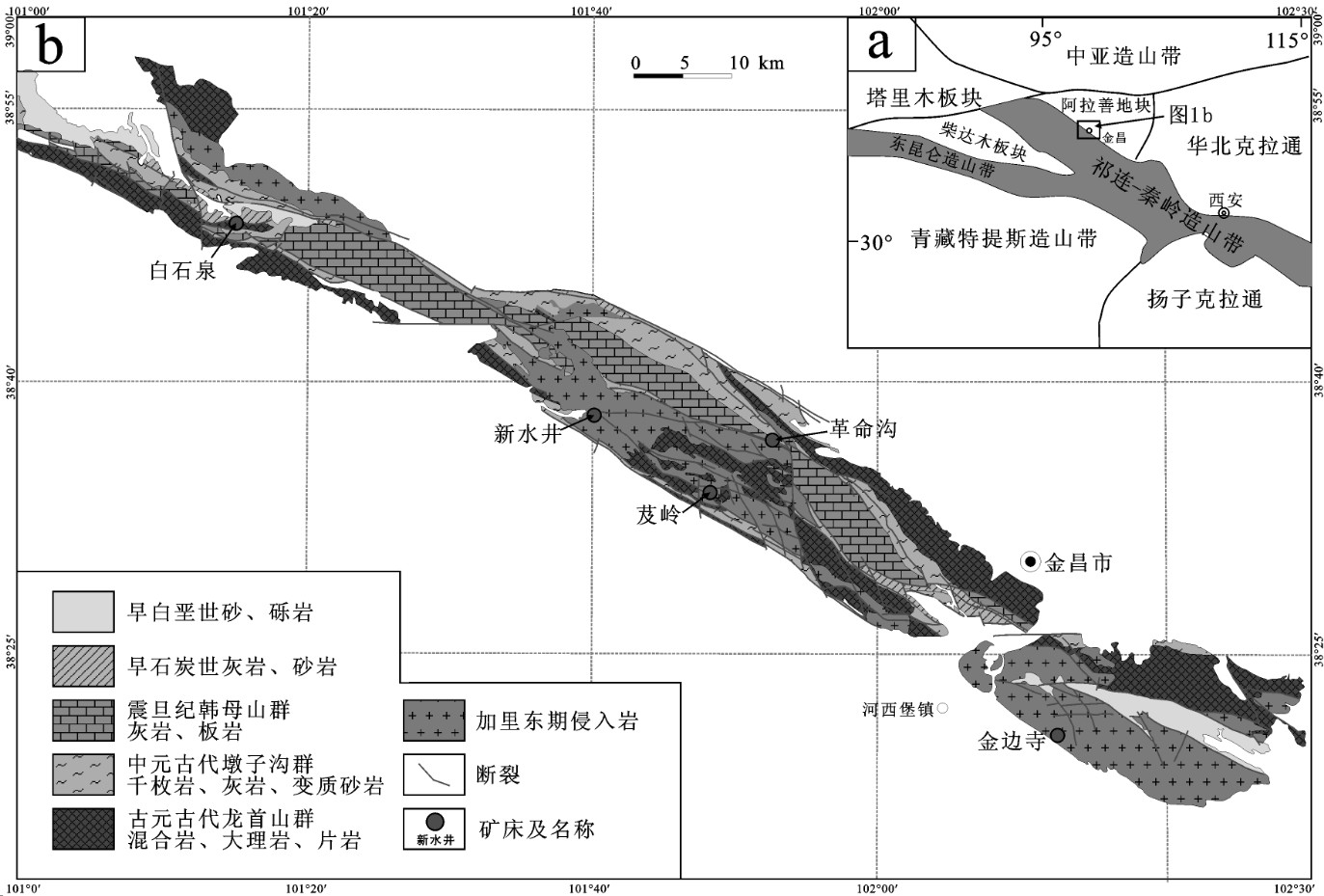
 下载:
下载:
